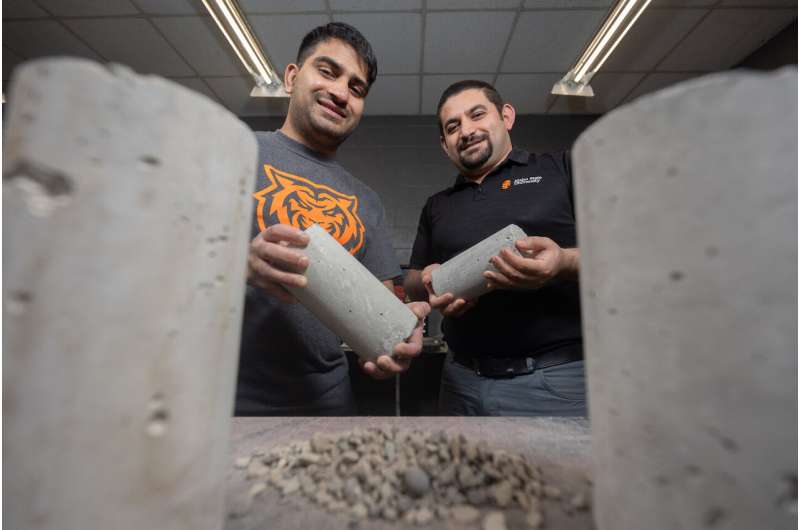
If you want to make more sustainable and environmentally friendly concrete, you're going to need some sugar. Sort of.
A new study published in Sustainability by researchers in Idaho State University's Department of Civil and Environmental Engineering shows swapping some of the cement found in concrete with precipitated calcium carbonate (PCC)—a waste product created when sugar beets are processed into refined sugar—it's possible to maintain the concrete's strength similar to conventional concrete.
PCC is chemically identical to its natural version, limestone, and to make cement currently, manufacturers heat limestone, clay, and other materials and then grind them into a powder. The process of making cement accounts for roughly 8% of all global carbon dioxide emissions, according to a 2018 report by the think tank Chatham House.
"I learned about the precipitated calcium carbonate from an undergraduate civil engineering student, Joe Shurtleff," said Mustafa Mashal, associate professor in the Department of Civil and Environmental Engineering and an expert in structural engineering. "There has been a push towards exploring eco-friendly substitutes to reduce cement consumption in concrete, and I immediately thought of exploring this material to partially replace the cement."
To test the hypothesis, the research team performed a series of small-scale tests on samples of concrete, each with varying amounts of PCC and a control sample(s) of conventional concrete. They found up to 30% of the cement used to make concrete can be replaced with precipitated calcium carbonate and still meet American Society for Testing and Materials standards.
In addition to exploring the greener possibilities for the cement, the research team also looked into using upcycled concrete aggregate instead of the sand or crushed stones commonly used as aggregates. Upcycled concrete aggregate is previously used concrete pieces that are crushed to the desired sizes for the project. Here, the results showed up to 100% of the aggregates can be replaced with upcycled concrete without sacrificing strength. A 2020 report by the Environmental Protection Agency said that 381 million tons, or two out of every three pounds of demolition debris, is attributable to concrete in the United States.
"Conventional concrete production generates substantial amounts of carbon emissions and consumes a significant quantity of raw materials on a global scale," said Kabiraj Phuyal, a graduate student studying civil engineering and lead author of the study. "Exploring greener and more sustainable options for concrete production is important in addressing environmental concerns. Additionally, the concrete we tested may offer a lower cost alternative for builders because it uses upcycled and recycled materials."
While the greener concrete's outlook is promising, it will still need to be submitted to more testing. From here, researchers plan to keep testing this new and more environmentally conscious concrete mix for its ability to resist freeze-thaw conditions, surface hardness, and more to determine its overall durability and if it can withstand real-world conditions.
"We have plans to build on our research and explore other aspects of this eco-friendly concrete using recycled and by-products that we have developed at ISU," Mashal said. "We are also collaborating with our industry partners to identify applications for these concrete mixes."
"Working on this project was an exciting and rewarding experience for me," Phuyal said. "It was an excellent opportunity to apply what I've learned and [practice] my skills on eco-friendly construction."
More information: Kabiraj Phuyal et al, A Sustainable and Environmentally Friendly Concrete for Structural Applications, Sustainability (2023). DOI: 10.3390/su152014694
Citation: Researchers develop greener building materials using sugar processing waste products (2023, November 28) retrieved 28 November 2023 from https://techxplore.com/news/2023-11-greener-materials-sugar-products.html
This document is subject to copyright. Apart from any fair dealing for the purpose of private study or research, no part may be reproduced without the written permission. The content is provided for information purposes only.
